German stage and film actor Werner Krauss (1884-1959) became a worldwide sensation as the demonic Dr. Caligari in the classic of the German expressionist cinema, Das Kabinett des Doktor Caligari/The Cabinet of Dr. Caligari (1919). He appeared in several silent masterpieces, but his magnificent film career was later overshadowed by his appearance in one of the most notorious propaganda films of the Third Reich.
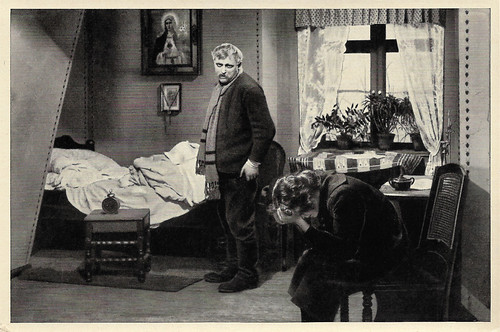
German photocard for the album Vom Werden Deutscher Filmkunst by Ross Verlag. Photo: Ufa. Werner Krauss in the classic German Kammerspiel film Scherben/Shattered (Lupu Pick, 1921). The woman is Edith Posca, who plays the daughter.
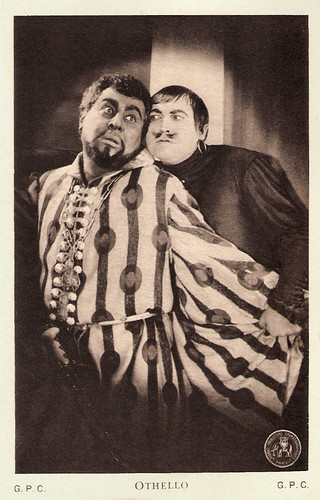
French postcard by Edition de la Cinématographie-Française, Paris. Photo: G.P.C. Publicity still for Othello (Dimitri Buchowetzki, 1922) with Emil Jannings as Othello.
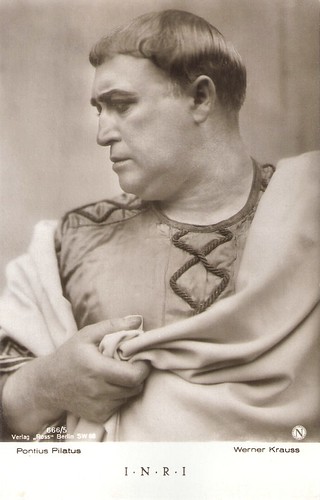
German postcard by Ross Verlag G.m.b.H., Berlin, no. 666/5, 1919-1924. Photo: Neumann-Filmproduktion. Publicity still for I.N.R.I./Crown of Thorns (Robert Wiene, 1923). Caption: Pontius Pilatus.

German postcard by Ross Verlag G.m.b.H., Berlin. Photo: Sofar-Film-Produktion. Publicity still for Die freudlose Gasse/The Joyless Street (Georg Wilhelm Pabst, 1925).

German photocard for the album Vom Werden Deutscher Filmkunst by Ross Verlag. Photo: Ufa. Werner Krauss in Geheimnisse einer Seele/Secrets of a Soul (G.W. Pabst, 1926).

German collectors card by Ross Verlag in the series Vom Werden deutscher Filmkunst - Der Stumme Film, picture no. 194, group 40. Photo: Ufa. Werner Krauss and Heinerle in Der fidele Bauer/The Merry Farmer (Franz Seitz, 1929).
Werner Johannes Krauss (Krauß in German) was born in Gestungshausen, Germany, in 1884. He was the son of a clergyman. He ran away from home and joined a travelling theatre company.
In Berlin, he became a film actor. Among his first films were Die Pagode/The Pagoda (Joe May, 1914), Nächte des Grauens/A Night of Horror (Richard Oswald, Arthur Robison, 1916) with Emil Jannings, Hoffmanns Erzählungen/Tales of Hoffmann (Richard Oswald, 1916) and Opium (Robert Reinert, 1919) with Conrad Veidt.
In 1916, he met the noted theatre director Max Reinhardt and went to work for him. Krauss had been trained to do exaggerated gestures for the stage, and the German expressionist cinema was but a short stylistic step further for him.
In 1919, he became a worldwide sensation for his demonic portrayal of Dr. Caligari in Robert Wiene's Das Kabinett des Dr. Caligari/The Cabinet of Dr. Caligari (1919). Dr. Caligari is a sinister hypnotist who travels the carnival circuit displaying a somnambulist named Cesare (Conrad Veidt). In one tiny German town, a series of murders coincides with Caligari's visit. Krauss was just 35 at the time he appeared in the film, but his heavy makeup made him seem older.
Doug Tomlinson at Film Reference: “In The Cabinet of Dr. Caligari Krauss epitomizes the German Expressionist performance aesthetic which would dominate the next decade: an obvious external expression of interiority. Throughout the central part of the film, Krauss hobbles through nightmare sets, his crippled walk an expression of a crippled mind, his dark and menacing facial and body makeup of the rot within, and his sparse and erratic white hair of his overall decrepitude. His posture, rounded inward to symbolize mystery and enclosure, refuses the spectator any sympathetic identification. At the film's end, when Caligari is shown to be the head of an asylum and the film the rantings of an inmate, Krauss expressionistically softens all aspects of posture and characterization to appear the epitome of benevolence.“

German postcard by Ross Verlag, no. 630/2. Werner Krauß as Rose's father, Henny Porten as Rose Bernd, and Hilde Müller (unknown part) in Rose Bernd (Alfred Halm, 1919), adapted from the eponymous play by Gerhard Hauptmann.
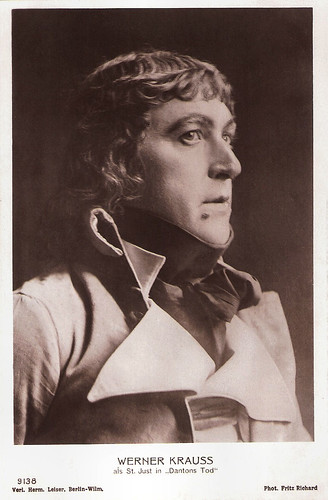
German postcard by Verlag Hermann Leiser, Berlin, no. 9138. Photo: Fritz Richard. Publicity for the stage play 'Dantons Tod' (The Death of Danton) with Werner Krauss as St. Just.

German postcard by NPG, no. 540. Photo: Alex Binder, Berlin.
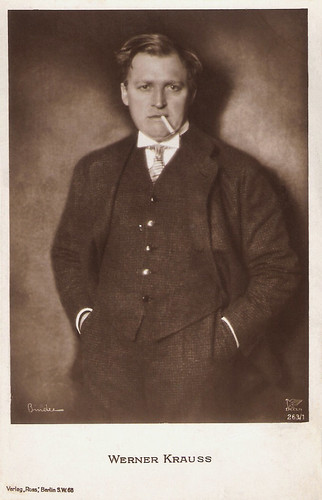
German postcard by Ross Verlag, Berlin, no. 263/1, 1919-1924. Photo: Alex Binder / Decla.
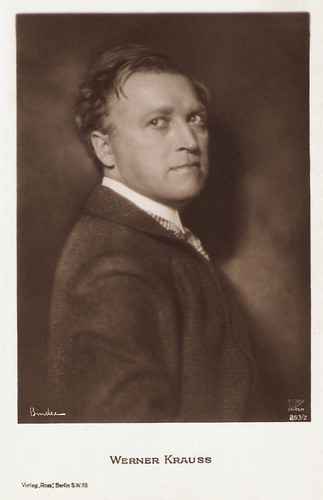
German postcard by Ross Verlag, Berlin, no. 263/2, 1919-1924. Photo: Alex Binder / Decla.
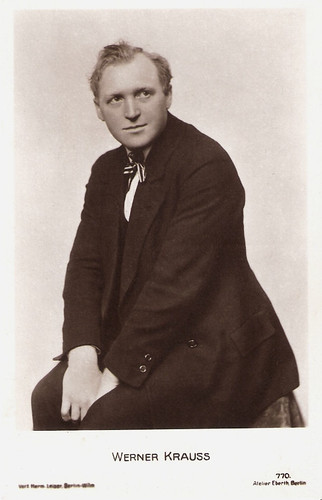
German postcard by Verlag Hermann Leiser, Berlin-Wilm., no. 770. Photo: Eberth, Berlin.
Werner Krauss’ heavy, declamatory technique was perfect for such roles as Bottom in Ein Sommernachtstraum/A Midsummer Night's Dream (Hans Neumann, 1924) and Jack the Ripper in Das Wachsfigurenkabinett/The Wax Works (Paul Leni, 1924) opposite Emil Jannings and Conrad Veidt.
He also played Iago in a 1922 adaptation of William Shakespeare's Othello (Dimitri Buchowetzki, 1922). Hal Erickson at AllMovie: “Even without the benefit of sound, the 1922 German adaptation of Othello seems more operatic than Shakespearean. This may be due to the casting of Emil Jannings, to whom restraint and subtlety were strangers. Werner Krauss, of Cabinet of Dr. Caligari fame, is on hand as the duplicitous Iago. Appearing as the unfortunate Desdemona is Lea Von Lenkeffy, better known as Lya de Putti. Produced on an elaborate scale, Othello may not be true to the letter of Shakespeare, but is undeniably a smorgasbord of visual delights.”
Krauss was again prominently featured in such silent masterpieces as Varieté/Jealousy (Ewald André Dupont, 1925), Herr Tartüff/Tartuffe (F.W. Murnau, 1925) based on the classic Molière play, and Der Student von Prag/The Man Who Cheated Life (Henrik Galeen, 1926).
He also worked internationally. In France, he appeared as the obsessed Count Muffat in Jean Renoir's version of Emile Zola's Nana (Jean Renoir, 1926). Totally submissive to the demands of the exploitative Nana, he ultimately disgraces himself by barking, sitting, rolling over, and playing dead like a dog. His utterly degraded character is reflected in his lumpish posture.
By 1926, Krauss had worked with such major directors as F.W. Murnau, G.W. Pabst, Lupu Pick, E. A. Dupont, Richard Oswald, Paul Leni, and Jean Renoir. He was one of the leading German film actors of his time, but his obsessed and evil characters became more and more a cliché.

German postcard by Ross Verlag, Berlin, no. 1613/1, 1927-1928. Photo: Atelier Domker, Berlin. Collection: Didier Hanson.

German postcard by Ross Verlag, Berlin, no. 1613/2, 1927-1928. Photo: Atelier Badekow-Grósz, Berlin.

Austrian postcard by Iris Verlag, no. 636.

Austrian postcard by Iris-Verlag, no. 5353. Photo: Fery-Film / Ifuk-Verleih. Publicity still for Der fidele Bauer/The Merry Farmer (Franz Seitz, 1929).

German postcard by Ross Verlag, no. 115/2. Photo: D.L.S. Werner Krauss in Napoleon auf St. Helena/Napoleon at St. Helena (Lupu Pick, 1929). The outfit of Krauss is that of Goethe in the famous painting 'Goethe in the Campagna' (1787) by Tischbein.
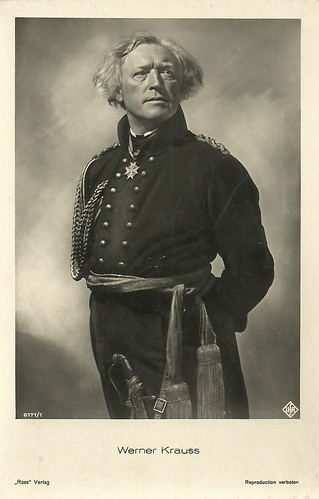
German postcard by Ross Verlag, no. 6171/1, 1930-1931. Photo: Ufa. Werner Krauss as the title character in Yorck (Gustav Ucicky, 1931).
When Adolf Hitler came to power, Werner Krauss clutched the Nazi ideology firmly to his bosom. He only incidentally played in films such as the charming Burgtheater/Burg Theatre (Willi Forst, 1936) with Olga Tschechova.
He was made an Actor of the State by Reich Minister of Propaganda Joseph Goebbels, and subsequently played the roles of two stereotypical Jewish characters – Rabbi Loew and Sekretar Levy – in Veit Harlan's notoriously antisemitic Jud Süß/Jew Süss (Veit Harlan, 1940).
Hal Erickson writes in his review at AllMovie: “Lion Feuchtwangler's novel Jud Süss was originally about a powerful ghetto businessman who believes himself to be a Jew. Süss's ruthless business practices result in the betrayal of an innocent girl, for which he is arrested and sentenced to be hanged under the anti-Jewish laws of the 18th century. While he waits to be executed, Süss discovers he is not Jewish. Rather than turn his back on the people of the ghetto with whom he'd grown up, Süss courageously refuses to declare his 'Aryan' status, even though it means he will die on the gallows. The Feuchtwangler book was designed in a roundabout fashion to strike a blow against anti-Semitism. But when Jud Süss was filmed in Germany at the behest of Nazi propaganda minister Joseph Goebbels in 1940, its original message was twisted and perverted into an argument in favour of 'ethnic cleansing'.”
Krauss also played Shylock in an extreme production of 'The Merchant of Venice' staged at Vienna's Burgtheater in 1943. After World War II, all associated with Jud Süss were plagued with recriminations for their participation, which drove Krauss out of the country for more than three years.
Leading German democrats registered emphatic opposition to his public appearances. In June of 1954, one of West Germany's highest decorations was ceremoniously conferred on him by West Berlin's cultural and education chief. The actor appeared in only three more films before his death. His final film was the Heimatfilm Sohn Ohne Heimat/Son Without a Homeland (Hans Deppe, 1955). Werner Krauss died in relative obscurity in Vienna, Austria in 1959. He was married to Marie Bard who died in 1944.
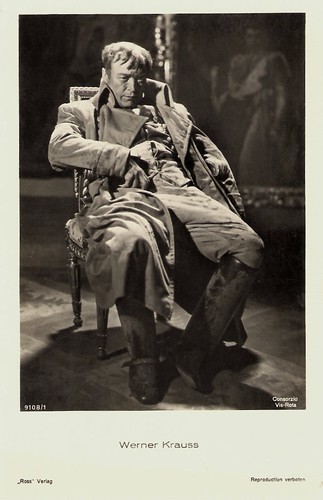
German postcard by Ross Verlag, no. 9108/1, 1935-1936. Photo: Consorzio Vis / Rota. Publicity still for Hundert Tage/Hundred Days (Franz Wenzler, 1935) with Werner Krauss as Napoleon.
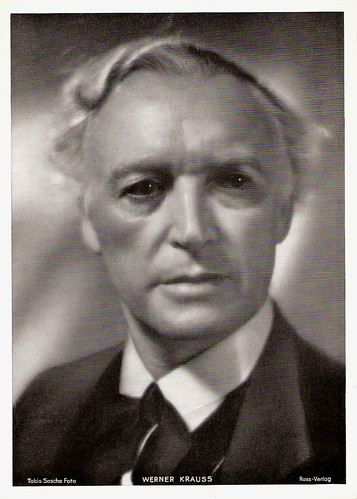
Big German card by Ross Verlag, Berlin. Photo: Tobis Sascha foto.

German postcard by Ross Verlag, Berlin, no. A 3264/1, 1941-1944. Photo: Foto Quick / Ufa.
Trailer Das Kabinett des Doktor Caligari/The Cabinet of Dr. Caligari (1919). Source: Movieclips Trailer Vault (YouTube).
Scene from Geheimnisse einer Seele/Secrets of a soul (1926). Source: sangrecoagulada (YouTube).
Sources: Hal Erickson (AllMovie - Page now defunct), Doug Tomlinson (Film Reference), Katzizkidz (Find A Grave), Wikipedia, and IMDb.
This post was last updated on 25 January 2025.

German photocard for the album Vom Werden Deutscher Filmkunst by Ross Verlag. Photo: Ufa. Werner Krauss in the classic German Kammerspiel film Scherben/Shattered (Lupu Pick, 1921). The woman is Edith Posca, who plays the daughter.

French postcard by Edition de la Cinématographie-Française, Paris. Photo: G.P.C. Publicity still for Othello (Dimitri Buchowetzki, 1922) with Emil Jannings as Othello.

German postcard by Ross Verlag G.m.b.H., Berlin, no. 666/5, 1919-1924. Photo: Neumann-Filmproduktion. Publicity still for I.N.R.I./Crown of Thorns (Robert Wiene, 1923). Caption: Pontius Pilatus.

German postcard by Ross Verlag G.m.b.H., Berlin. Photo: Sofar-Film-Produktion. Publicity still for Die freudlose Gasse/The Joyless Street (Georg Wilhelm Pabst, 1925).

German photocard for the album Vom Werden Deutscher Filmkunst by Ross Verlag. Photo: Ufa. Werner Krauss in Geheimnisse einer Seele/Secrets of a Soul (G.W. Pabst, 1926).

German collectors card by Ross Verlag in the series Vom Werden deutscher Filmkunst - Der Stumme Film, picture no. 194, group 40. Photo: Ufa. Werner Krauss and Heinerle in Der fidele Bauer/The Merry Farmer (Franz Seitz, 1929).
Worldwide sensation
Werner Johannes Krauss (Krauß in German) was born in Gestungshausen, Germany, in 1884. He was the son of a clergyman. He ran away from home and joined a travelling theatre company.
In Berlin, he became a film actor. Among his first films were Die Pagode/The Pagoda (Joe May, 1914), Nächte des Grauens/A Night of Horror (Richard Oswald, Arthur Robison, 1916) with Emil Jannings, Hoffmanns Erzählungen/Tales of Hoffmann (Richard Oswald, 1916) and Opium (Robert Reinert, 1919) with Conrad Veidt.
In 1916, he met the noted theatre director Max Reinhardt and went to work for him. Krauss had been trained to do exaggerated gestures for the stage, and the German expressionist cinema was but a short stylistic step further for him.
In 1919, he became a worldwide sensation for his demonic portrayal of Dr. Caligari in Robert Wiene's Das Kabinett des Dr. Caligari/The Cabinet of Dr. Caligari (1919). Dr. Caligari is a sinister hypnotist who travels the carnival circuit displaying a somnambulist named Cesare (Conrad Veidt). In one tiny German town, a series of murders coincides with Caligari's visit. Krauss was just 35 at the time he appeared in the film, but his heavy makeup made him seem older.
Doug Tomlinson at Film Reference: “In The Cabinet of Dr. Caligari Krauss epitomizes the German Expressionist performance aesthetic which would dominate the next decade: an obvious external expression of interiority. Throughout the central part of the film, Krauss hobbles through nightmare sets, his crippled walk an expression of a crippled mind, his dark and menacing facial and body makeup of the rot within, and his sparse and erratic white hair of his overall decrepitude. His posture, rounded inward to symbolize mystery and enclosure, refuses the spectator any sympathetic identification. At the film's end, when Caligari is shown to be the head of an asylum and the film the rantings of an inmate, Krauss expressionistically softens all aspects of posture and characterization to appear the epitome of benevolence.“

German postcard by Ross Verlag, no. 630/2. Werner Krauß as Rose's father, Henny Porten as Rose Bernd, and Hilde Müller (unknown part) in Rose Bernd (Alfred Halm, 1919), adapted from the eponymous play by Gerhard Hauptmann.

German postcard by Verlag Hermann Leiser, Berlin, no. 9138. Photo: Fritz Richard. Publicity for the stage play 'Dantons Tod' (The Death of Danton) with Werner Krauss as St. Just.

German postcard by NPG, no. 540. Photo: Alex Binder, Berlin.

German postcard by Ross Verlag, Berlin, no. 263/1, 1919-1924. Photo: Alex Binder / Decla.

German postcard by Ross Verlag, Berlin, no. 263/2, 1919-1924. Photo: Alex Binder / Decla.

German postcard by Verlag Hermann Leiser, Berlin-Wilm., no. 770. Photo: Eberth, Berlin.
A smorgasbord of visual delights
Werner Krauss’ heavy, declamatory technique was perfect for such roles as Bottom in Ein Sommernachtstraum/A Midsummer Night's Dream (Hans Neumann, 1924) and Jack the Ripper in Das Wachsfigurenkabinett/The Wax Works (Paul Leni, 1924) opposite Emil Jannings and Conrad Veidt.
He also played Iago in a 1922 adaptation of William Shakespeare's Othello (Dimitri Buchowetzki, 1922). Hal Erickson at AllMovie: “Even without the benefit of sound, the 1922 German adaptation of Othello seems more operatic than Shakespearean. This may be due to the casting of Emil Jannings, to whom restraint and subtlety were strangers. Werner Krauss, of Cabinet of Dr. Caligari fame, is on hand as the duplicitous Iago. Appearing as the unfortunate Desdemona is Lea Von Lenkeffy, better known as Lya de Putti. Produced on an elaborate scale, Othello may not be true to the letter of Shakespeare, but is undeniably a smorgasbord of visual delights.”
Krauss was again prominently featured in such silent masterpieces as Varieté/Jealousy (Ewald André Dupont, 1925), Herr Tartüff/Tartuffe (F.W. Murnau, 1925) based on the classic Molière play, and Der Student von Prag/The Man Who Cheated Life (Henrik Galeen, 1926).
He also worked internationally. In France, he appeared as the obsessed Count Muffat in Jean Renoir's version of Emile Zola's Nana (Jean Renoir, 1926). Totally submissive to the demands of the exploitative Nana, he ultimately disgraces himself by barking, sitting, rolling over, and playing dead like a dog. His utterly degraded character is reflected in his lumpish posture.
By 1926, Krauss had worked with such major directors as F.W. Murnau, G.W. Pabst, Lupu Pick, E. A. Dupont, Richard Oswald, Paul Leni, and Jean Renoir. He was one of the leading German film actors of his time, but his obsessed and evil characters became more and more a cliché.

German postcard by Ross Verlag, Berlin, no. 1613/1, 1927-1928. Photo: Atelier Domker, Berlin. Collection: Didier Hanson.

German postcard by Ross Verlag, Berlin, no. 1613/2, 1927-1928. Photo: Atelier Badekow-Grósz, Berlin.

Austrian postcard by Iris Verlag, no. 636.

Austrian postcard by Iris-Verlag, no. 5353. Photo: Fery-Film / Ifuk-Verleih. Publicity still for Der fidele Bauer/The Merry Farmer (Franz Seitz, 1929).

German postcard by Ross Verlag, no. 115/2. Photo: D.L.S. Werner Krauss in Napoleon auf St. Helena/Napoleon at St. Helena (Lupu Pick, 1929). The outfit of Krauss is that of Goethe in the famous painting 'Goethe in the Campagna' (1787) by Tischbein.

German postcard by Ross Verlag, no. 6171/1, 1930-1931. Photo: Ufa. Werner Krauss as the title character in Yorck (Gustav Ucicky, 1931).
Actor of the state
When Adolf Hitler came to power, Werner Krauss clutched the Nazi ideology firmly to his bosom. He only incidentally played in films such as the charming Burgtheater/Burg Theatre (Willi Forst, 1936) with Olga Tschechova.
He was made an Actor of the State by Reich Minister of Propaganda Joseph Goebbels, and subsequently played the roles of two stereotypical Jewish characters – Rabbi Loew and Sekretar Levy – in Veit Harlan's notoriously antisemitic Jud Süß/Jew Süss (Veit Harlan, 1940).
Hal Erickson writes in his review at AllMovie: “Lion Feuchtwangler's novel Jud Süss was originally about a powerful ghetto businessman who believes himself to be a Jew. Süss's ruthless business practices result in the betrayal of an innocent girl, for which he is arrested and sentenced to be hanged under the anti-Jewish laws of the 18th century. While he waits to be executed, Süss discovers he is not Jewish. Rather than turn his back on the people of the ghetto with whom he'd grown up, Süss courageously refuses to declare his 'Aryan' status, even though it means he will die on the gallows. The Feuchtwangler book was designed in a roundabout fashion to strike a blow against anti-Semitism. But when Jud Süss was filmed in Germany at the behest of Nazi propaganda minister Joseph Goebbels in 1940, its original message was twisted and perverted into an argument in favour of 'ethnic cleansing'.”
Krauss also played Shylock in an extreme production of 'The Merchant of Venice' staged at Vienna's Burgtheater in 1943. After World War II, all associated with Jud Süss were plagued with recriminations for their participation, which drove Krauss out of the country for more than three years.
Leading German democrats registered emphatic opposition to his public appearances. In June of 1954, one of West Germany's highest decorations was ceremoniously conferred on him by West Berlin's cultural and education chief. The actor appeared in only three more films before his death. His final film was the Heimatfilm Sohn Ohne Heimat/Son Without a Homeland (Hans Deppe, 1955). Werner Krauss died in relative obscurity in Vienna, Austria in 1959. He was married to Marie Bard who died in 1944.

German postcard by Ross Verlag, no. 9108/1, 1935-1936. Photo: Consorzio Vis / Rota. Publicity still for Hundert Tage/Hundred Days (Franz Wenzler, 1935) with Werner Krauss as Napoleon.

Big German card by Ross Verlag, Berlin. Photo: Tobis Sascha foto.

German postcard by Ross Verlag, Berlin, no. A 3264/1, 1941-1944. Photo: Foto Quick / Ufa.
Trailer Das Kabinett des Doktor Caligari/The Cabinet of Dr. Caligari (1919). Source: Movieclips Trailer Vault (YouTube).
Scene from Geheimnisse einer Seele/Secrets of a soul (1926). Source: sangrecoagulada (YouTube).
Sources: Hal Erickson (AllMovie - Page now defunct), Doug Tomlinson (Film Reference), Katzizkidz (Find A Grave), Wikipedia, and IMDb.
This post was last updated on 25 January 2025.
No comments:
Post a Comment